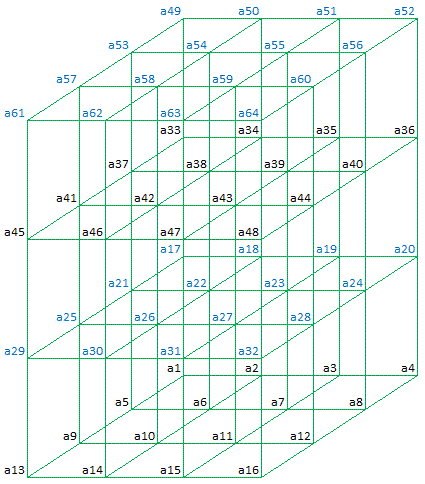Office Applications and Entertainment, Magic Cubes | ||
|
|
Index | About the Author |
|
3.8 Pandiagonal/Triagonal Magic Cubes (4 x 4 x 4)
The cube shown below is a Pan Diagonal/Triagonal Magic Cube of the 4th order,
meaning a Magic Cube for which all (Pan) Diagonals and (Pan) Triagonals sum to the Magic Constant.
|

|
|
|
A Pandiagonal/Triagonal Magic Cube can be transformed into another Pandiagonal/Triagonal Magic Cube by moving an orthogonal plane from one side of the cube to the other.
In general Magic Cubes of order 4 can be represented as follows:
|

|
|
|
After deduction of the defining equations (160), the following set of linear equations - describing the Pan Diagonal/Triagonal Magic Cubes of the 4th order - can be obtained: a(54) = a(56) + a(62) - a(64) a(53) = a(55) + a(61) - a(63) a(52) = s1 - a(55) - a(58) - a(61) a(51) = s1 - a(56) - a(57) - a(62) a(50) = s1 - a(55) - a(60) - a(61) a(49) = s1 - a(56) - a(59) - a(62) a(46) = a(48) - a(58) + a(60) a(45) = a(47) - a(57) + a(59) a(44) = s1 - a(47) - a(59) - a(64) a(43) = s1 - a(48) - a(60) - a(63) a(42) = s1 - a(47) - a(59) - a(62) a(41) = s1 - a(48) - a(60) - a(61) a(40) = a(48) - a(55) + a(63) a(39) = a(47) - a(56) + a(64) a(38) = a(48) - a(55) - a(58) + a(60) + a(63) a(37) = a(47) - a(56) - a(57) + a(59) + a(64) a(36) = - a(47) + a(56) + a(57) + a(62) - a(64) a(35) = - a(48) + a(55) + a(58) + a(61) - a(63) a(34) = - a(47) + a(56) + a(57) a(33) = - a(48) + a(55) + a(58) a(32) = 0.5 * s1 - a(56) - a(62) + a(64) a(31) = 0.5 * s1 - a(55) - a(61) + a(63) a(30) = 0.5 * s1 - a(56) a(29) = 0.5 * s1 - a(55) a(28) = -0.5 * s1 + a(55) + a(60) + a(61) a(27) = -0.5 * s1 + a(56) + a(59) + a(62) a(26) = -0.5 * s1 + a(55) + a(58) + a(61) a(25) = -0.5 * s1 + a(56) + a(57) + a(62) a(24) = 0.5 * s1 - a(62) a(23) = 0.5 * s1 - a(61) a(22) = 0.5 * s1 - a(64) a(21) = 0.5 * s1 - a(63) a(20) = 0.5 * s1 - a(58) a(19) = 0.5 * s1 - a(57) a(18) = 0.5 * s1 - a(60) a(17) = 0.5 * s1 - a(59) a(16) = 0.5 * s1 - a(48) + a(55) + a(58) - a(60) - a(63) a(15) = 0.5 * s1 - a(47) + a(56) + a(57) - a(59) - a(64) a(14) = 0.5 * s1 - a(48) + a(55) - a(63) a(13) = 0.5 * s1 - a(47) + a(56) - a(64) a(12) = 0.5 * s1 + a(47) - a(56) - a(57) a(11) = 0.5 * s1 + a(48) - a(55) - a(58) a(10) = 0.5 * s1 + a(47) - a(56) - a(57) - a(62) + a(64) a( 9) = 0.5 * s1 + a(48) - a(55) - a(58) - a(61) + a(63) a( 8) = 0.5 * s1 - a(48) + a(58) - a(60) a( 7) = 0.5 * s1 - a(47) + a(57) - a(59) a( 6) = 0.5 * s1 - a(48) a( 5) = 0.5 * s1 - a(47) a( 4) = -0.5 * s1 + a(47) + a(59) + a(62) a( 3) = -0.5 * s1 + a(48) + a(60) + a(61) a( 2) = -0.5 * s1 + a(47) + a(59) + a(64) a( 1) = -0.5 * s1 + a(48) + a(60) + a(63)
The linear equations shown above, are ready to be solved, for the Magic Constant 130.
0 < a(i) =< 64 for i = 1, 2 ... 46, 49 ... 54
which can be incorporated in a guessing routine, which might be used to find other 4th order Pan Diagonal/Triagonal Magic Cubes.
|
|
|
Index | About the Author |